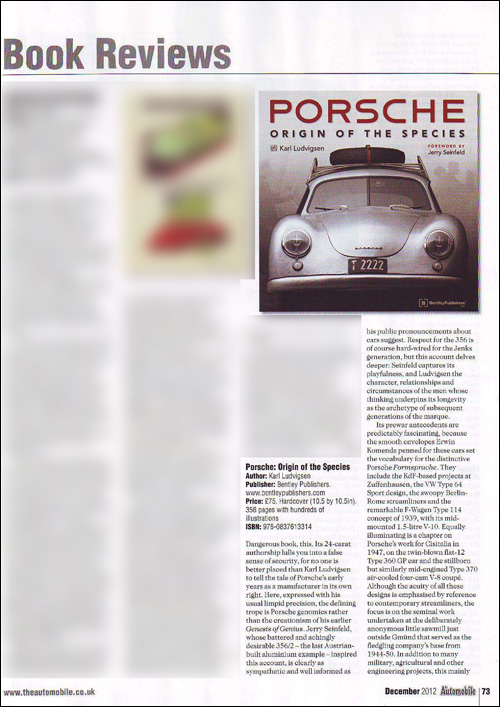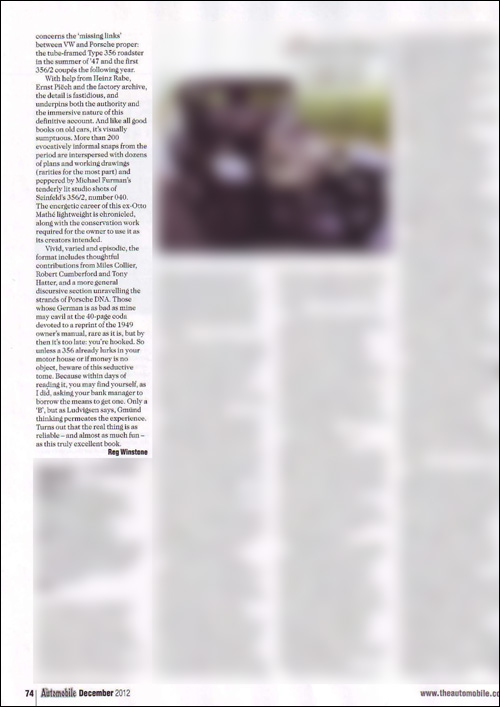|
Porsche - Origin of the Species
Price: $189.95
|
The Automobile - December 2012
Dangerous book, this. Its 24-carat authorship lulls you into a false sense of security, for no one is better placed than Karl Ludvigsen to tell the tale of Porsche's early years as a manufacturer in its own right. Here, expressed with his usual limpid precision, the defining trope is Porsehe genomics rather than the creationism of his earlier Genesis of Genius. Jerry Seinfeld, whose battered and achingly desirable 356/2 - the last Austrian built aluminium example - inspired this account, is clearly as sympathetic and well informed as his public pronouncements about cars suggest. Respect for the 356 is of course hard-wired for the Jenks generation, but this account delves deeper: Seinfeld captures its playfulness, and Ludvigsen the character, relationships and circumstances of the men whose thinking underpins its longevity as the archetype of subsequent generations of the marque.
Its prewar antecedents are predictably fascinating, because the smooth envelopes Erwin Komenda penned for these cars set the vocabulary for the distinctive Porsche Formsprache. They include the KdF-based projects at Zuffenhausen, the VW Type 64 Sport design, the swoopy Berlin-Rome streamliners and the remarkable F-Wagen Type 114 concept of 1939, with its mid-mounted 1.5-litre V-lO. Equally illuminating is a chapter on Porsche's work for Cisitalia in 1947, on the twin-blown flat-12 Type 360 GP car and the stillborn but similarly mid-engined Type 370 air-cooled four-cam V-8 coupé. Although the acuity of all these designs is emphasised by reference to contemporary streamliners, the focus is on the seminal work undertaken at the deliberately anonymous little sawmill just outside Gmünd that served as the fledgling company's base from 1944-50. In addition to many military, agricultural and other engineering projects, this mainly concerns the 'missing links' between VW and Porsche proper: the tube-framed Type 356 roadster in the summer of '47 and the first 356/2 coupés the following year.
With help from Heinz Rabe, Ernst Piëch and the factory archive, the detail is fastidious, and underpins both the authority and the immersive nature of this definitive account. And like all good books on old cars, it's visually sumptuous. More than 200 evocatively informal snaps from the period are interspersed with dozens of plans and working drawings (rarities for the most part) and peppered by Michael Furman's tenderly lit studio shots of Seinfeld's 356/2, number 040. The energetic career of this ex-Otto Mathé lightweight is chronicled, along with the conservation work required for the owner to use it as its creators intended.
Vivid, varied and episodic, the format includes thoughtful contributions from Miles Collier, Robert Cumberford and Tony Hatter, and a more general discursive section unravelling the strands of Porsche DNA. Those whose German is as bad as mine may cavil at the 40-page coda devoted to a reprint of the 1949 owner's manual, rare as it is, but by then it's too late: you're hooked. So unless a 356 already lurks in your motor house or if money is no object, beware of this seductive tome. Because within days of reading it, you may find yourself, as I did, asking your bank manager to borrow the means to get one. Only a 'B', but as Ludvigsen says, Gmünd thinking permeates the experience. Turns out that the real thing is as reliable - and almost as much fun - as this truly excellent book.


Review from and courtesy of The Automobile
![[B] Bentley Publishers](http://assets1.bentleypublishers.com/images/bentley-logos/bp-banner-234x60-bookblue.jpg)

